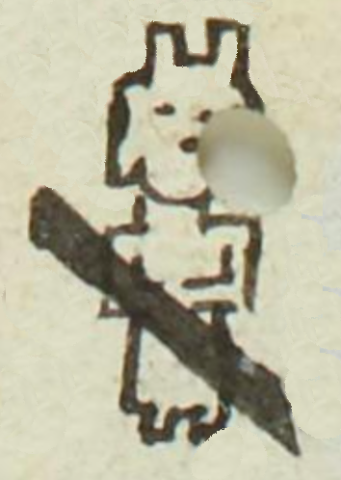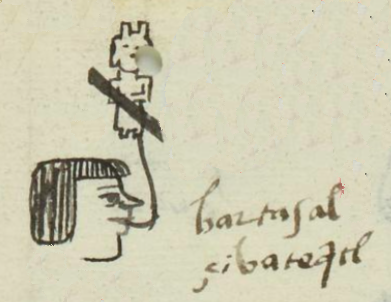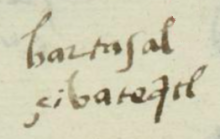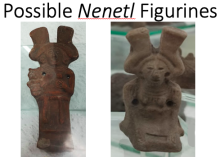Cihuatequitl (MH625r)
This compound personal name, Cihuatequitl ("Womanly Work," attested here as a man's name), shows a frontal view of what may be a female (cihuatl) doll of figuring of a divine force (nenetl) wearing a skirt. The figure holds a long, thin obsidian blade, which could be used to cut (tequi) things. This would provide a phonetic indicator for work (tequitl). For a photo of a cache of obsidian from c. 1400 in Tlatelolco, see this INAH link. The way she holds the tool makes it also resemble a huictli, an agricultural tool and a symbol for work (tequitl). If the latter is meant, the compound would be fully logographic.
Stephanie Wood
Keiko Yoneida has written about the use of "nenetl" to refer to genitals and "fetiches," especially in relation to the nemontemi days of the calendar. The negative reading of "nenetl" as useless or in vain, she suggests, is patriarchal. [See: Los Mapas de Cuauhtinchan y la historia cartográfica prehispánica (1991), 140.] Here, the glyph for "women's work" could carry that negativity, even if not visual.
Most examples of nenetl glyphs or elements can appear more like dolls or deity sculptures, sometimes female and sometimes male. Nearly always these figurines represent the syllable/phonogram "nen," which is the negative that refers to idleness or low productivity mentioned by Yoneda. The typical iconography of these nenetl figurines includes two squared-off protrusions on the top of the head. Occasionally, these can resemble deity glyphs, such as Cuauhtecolotl or Xolotl (below). Some have asked if these might be stylized representations of the typical Nahua woman's hairstyle, the neaxtlahualli, with the ends of two locks appearing above the forehead, one on each side. There is a precedent for these protrusions on the head found on pre-contact figurines of women. An impressive collection of these appears in the Museo Tomás Medina Villarruel in Tlahuac, CDMX, in photographs by Eduardo Flores. These figurines show women with breasts and skirts, and they can be grinding maize or carrying children. They have the squared-off shapes on the tops of their heads. These figurines do not necessarily cast women in a negative light, at least not visually.
Stephanie Wood
bartasal
çivateq~tl
Baltazar Cihuatequitl
Stephanie Wood
1560
Jeff Haskett-Wood
woman, mujer, obsidiana, cuchillo, trabajo, coa, nombres de hombres
Photo credit: Eduardo Flores. Museo Tomás Medina Villarruel, Tlahuac, CDMX.

cihua(tl), woman, https://nahuatl.wired-humanities.org/content/cihuatl
tequi(tl), work, https://nahuatl.wired-humanities.org/content/tequitl
tequi, to work, https://nahuatl.wired-humanities.org/content/tequi
Trabajo de Mujeres
Stephanie Wood
Matrícula de Huexotzinco, folio 625r, World Digital Library, https://www.loc.gov/resource/gdcwdl.wdl_15282/?sp=332st=image.
This manuscript is hosted by the Library of Congress and the World Digital Library; used here with the Creative Commons, “Attribution-NonCommercial-ShareAlike 3.0 License” (CC-BY-NC-SAq 3.0).










